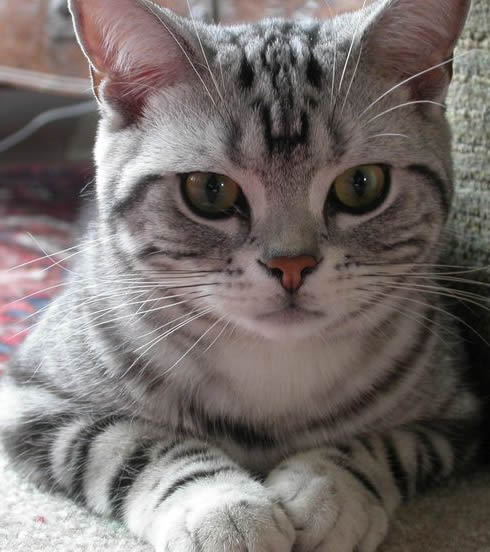Breed Standard
Head: Medium in size. Broad and fairly round. Rounded skull. Prominent cheekbones. Definite jowls in mature males. Square, well-developed muzzle. Slight whisker break. Moderately short nose shows a gentle, concave curve. Square, well-developed chin.
Eyes: Large, round, expressive, and wide set. Color in harmony with coat color is preferred.
Neck: Moderately short, well-muscled.
Body: Medium to large. Broad chest. Medium in bone. Powerfully muscled.
Paw: Medium in length and bone. Well muscled. Round, medium-sized paws; small and oval.
Tail: Length in proportion to body. Heavy from the base to the rounded tip. Carried nearly in line with the back.
Coat: Short, tight, and even. Coarse and hard to the touch. Slightly crimped, ending in a slight hook. Whiskers and ear furnishings are also curly. All colors permissible except chocolate, lilac, and colorpoint.
Fault: Deep nose break. Long, pointed, or close-set ears. Color of eyes not entirely green in Silver Wirehairs, color other than yellow in Brown Wirehairs. Overly short or long neck. Overly thin or short tail. Tail carried over the back. Fine, long, silky coat. Disqualify: White lockets or buttons.
History
The Wirehair's unusual coarse, prickly coat was caused by the spontaneous mutation of a gene. In 1966 on a farm in Verona, New York, the American Wirehair made its debut in a litter of American Shorthairs. Its crimped, coarse coat was the result of the spontaneous mutation of a dominant gene. The first-ever Wirehair was a red-and-white kitten named Adam. Breeder Joan O'Shea began a selective breeding program, crossing the Wirehairs with American Shorthairs to avoid excessive inbreeding and to develop the breed. The American Wirehair was officially recognized in the United States in 1978. Wirehairs were first imported to France in 1972. Still rather uncommon in the United States, this breed is extremely rare in Europe.
Behavior
This solidly built, highly active, agile, and playful cat needs exercise to burn off its abundant energy. The American Wirehair is social, affectionate, and gentle, demonstrating the same excellent character as its American Shorthair relative. Wirehair cats shed in the spring and fall like other cats, but due to the delicate nature of the coat, they should not be brushed. They may require bathing due to oily skin.
Health
Breeders find them easy to care for, resistant to disease, and good producers.






